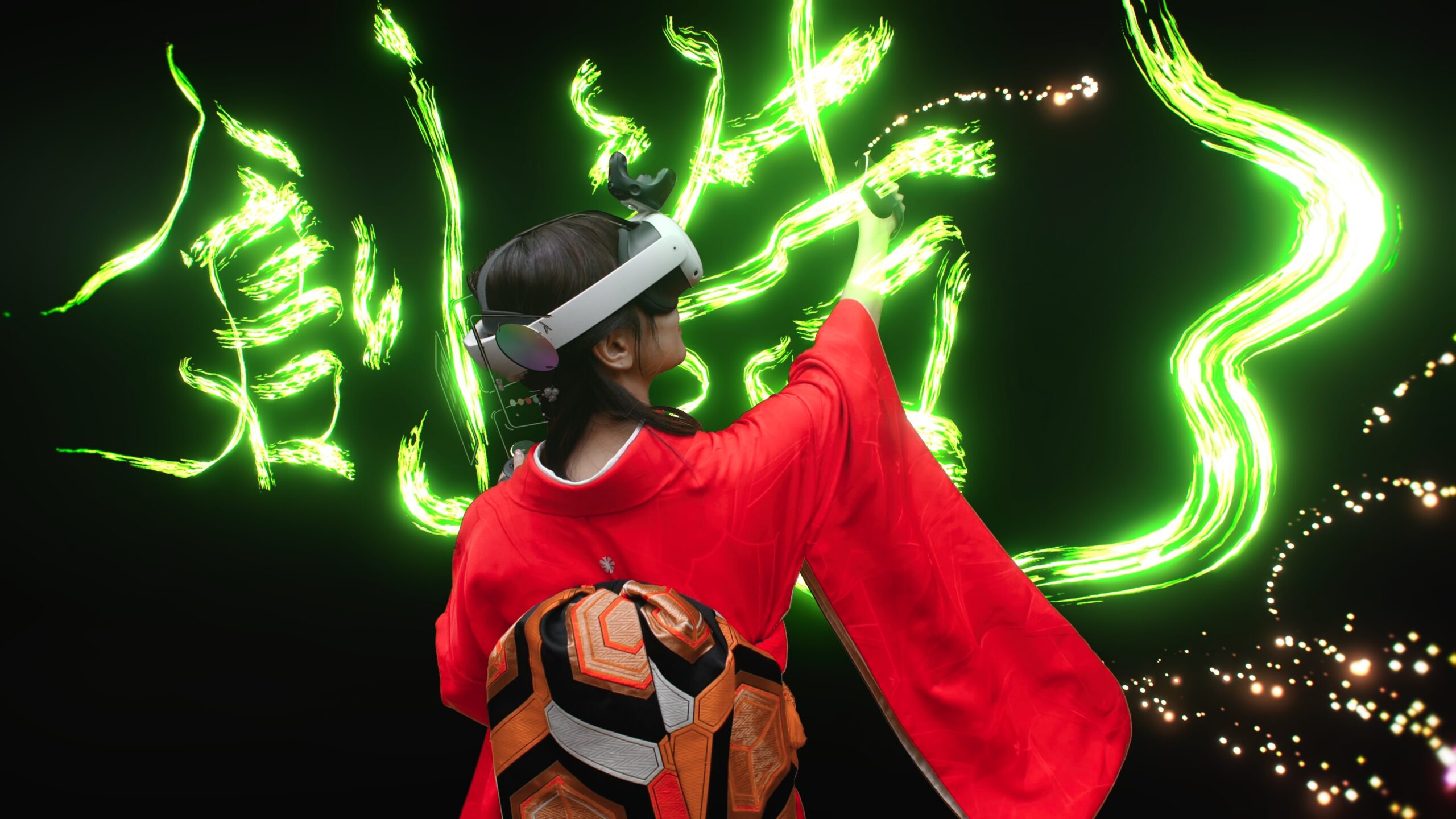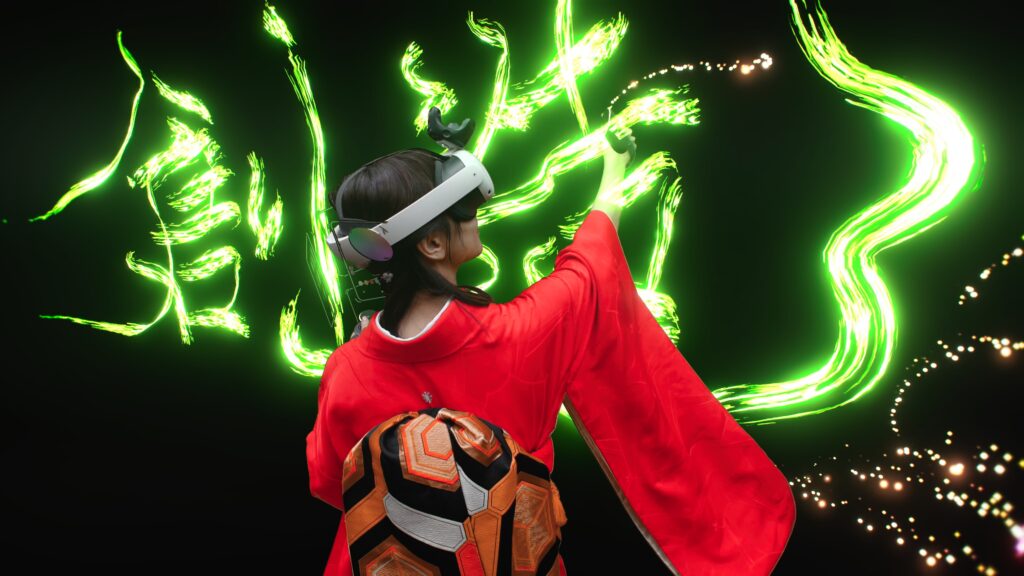
Bisen Aoyagi, a calligrapher who continues to challenge herself to create new expressions while preserving traditional Japanese culture, has held a brush since the age of four and has been fascinated by the profound world of calligraphy, pursuing her own unique expression by fusing tradition and innovation. The calligraphy she produces is powerful, dynamic and deeply spiritual, and has touched the hearts of many people. In this interview, she explains how her calligraphy came to be, her experience of performing calligraphy, her collaborations with different art forms and the possibilities of calligraphy in the future. It also looks at her exchange and collaboration with different cultures and her vision for the future of calligraphy, and explores the “possibilities of calligraphy” that Bisen Aoyagi wants to convey. Through words and brushstrokes, she weaves out the answer to what “calligraphy” means to her.
Q: Why did you decide to take up calligraphy?
I started learning calligraphy at the age of four under the influence of my grandmother, who was born in a temple and worked as a Japanese dressmaker.
I grew up surrounded by traditional Japanese culture, such as flowers, tea ceremony and kimonos, and I liked calligraphy best, which I started as a pastime in my grandmother’s Japanese-style room. I attended calligraphy classes until I graduated from high school and then went on to university and graduate school to specialise in calligraphy.
Q: How did you establish your “identity” as a calligrapher?
I was greatly shocked when I learnt the difference between “shuji” and “shodo” at university. For me, who had been pursuing beautiful writing, calligraphy was a profoundly new world. I learnt the importance of impressing the audience through my calligraphy performances, which I started in order to rebuild a calligraphy club that was on the verge of closure. Through this experience, I aimed to create works that moved people’s hearts. Through various challenges, my powerful and dynamic style came to be recognised as “the calligraphy of the soul of Bisen Aoyagi”, and I naturally established my own style.
Q: What has been the most memorable event in your life as a calligrapher?
I was given the opportunity to give a calligraphy performance and dedicate a work of calligraphy at the World Heritage Site Kongobuji Temple on Mt Koya, in commemoration of the 1,250th anniversary of the birth of Kobo-Daishi. During my stay, I enjoyed vegetarian food, Ajikan meditation and the morning service. On the day of the puja, I was given the opportunity to write ‘Henjyou’ on a giant folding screen. The moment I finished writing, I naturally burst into tears at the sensation of my body being wrapped in warmth, and it remains deeply in my mind as a special experience.
Q: Do you get inspiration from art or culture other than calligraphy?
I get a lot of inspiration from my experiences abroad and the cultures I come into contact with. Through cityscapes, architecture, fashion, contemporary art, museums and cultural heritage, I often get inspiration for new forms of expression. In particular, exposure to artworks that reflect different cultures and histories allows me to incorporate new perspectives and ideas into my own work. Furthermore, I also learn a lot from my interactions and dialogues with people in different countries, which I reflect in my own creative work.
Q: Are there any calligraphers or artists who have influenced you?
My greatest influence has been Kobo-Daishi (Kukai), whom I have studied for many years. While studying calligraphy through calligraphy, I have also received a lot of inspiration from contemporary artists such as Takashi Murakami and Kohei Nawa. I sympathise with the attitude of combining tradition and innovation, and by incorporating this into my own expression, I continue to search for new possibilities. Furthermore, I am evolving my own expression by incorporating the diverse values of contemporary society.
Q: What is the most important thing you keep in mind when creating your work?
The most important thing when creating my work is the legibility of the text. It is also important to consciously incorporate “white space” outside of the written text. Margins are not mere blank spaces, but are an important element of the work together with the letters. The placement and balance of the margins can create rhythm and tension in the space, and bring out visual depth and three-dimensionality.
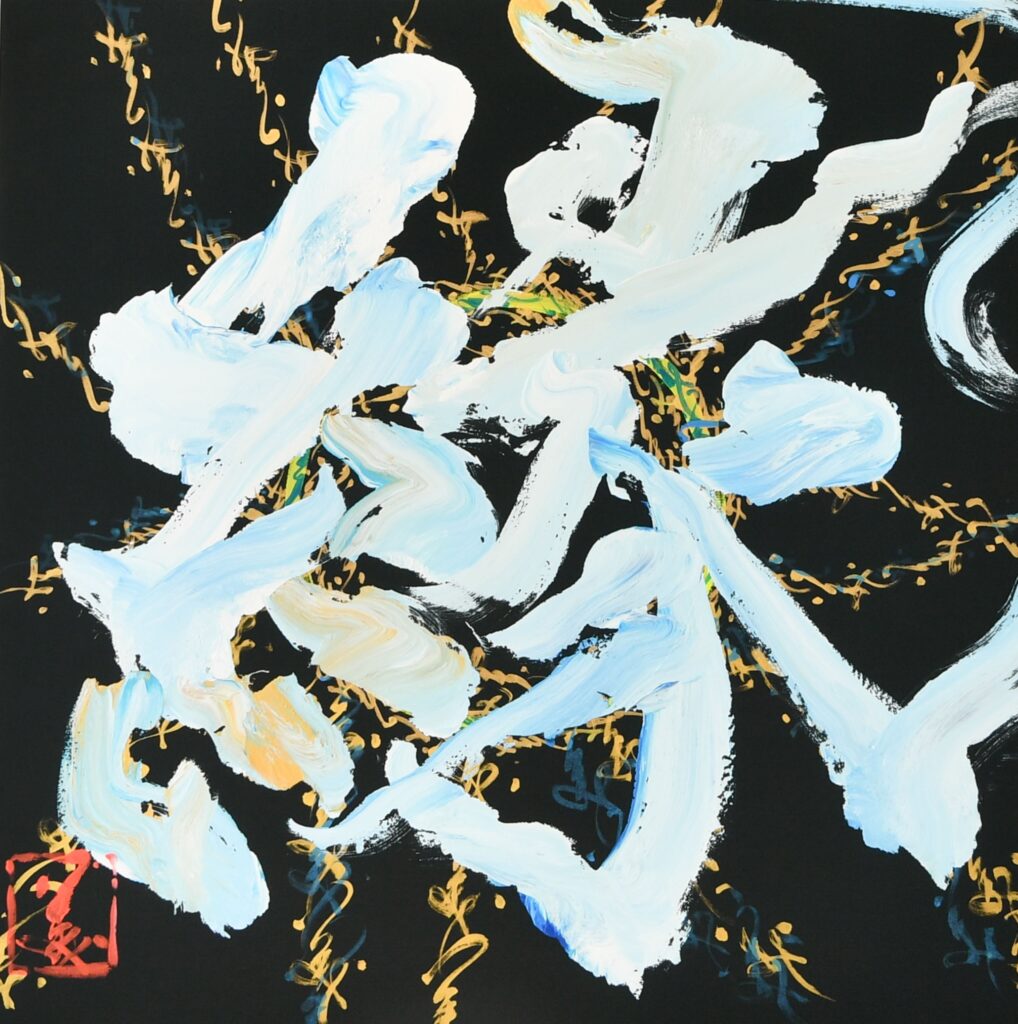
Q: Are you particular about the tools you use, such as ink, brushes and paper?
Yes, I am particular. The Four Treasures of Literature (brush, ink, inkstone and paper) are all important, but this time I would like to talk about the ink and brush. Ink is called “koboku” when it has been aged for 30 to 50 years. When it has matured in good condition, the glue component loosens and the colour becomes very tasteful. I learnt this from my mentor at university, who talked about eating ink, and I place great importance on expressing this aged nuance in my work. I have more than 100 brushes, which I select and use according to the work. Sometimes I have more than one of the same brush, and sometimes I have brushes custom-made to my liking.
Q: What do you think are the characteristics of your calligraphy?
I am often described as ‘strong, dynamic, vital, innovative and energetic.’ For me personally, tradition and innovation are important. I continue to practise under the same teachers that I still study under today. I have two axes – my pursuit of artistry and my study of traditional calligraphy – and I feel that the fusion of these two axes creates my own unique expression and character.
Q: What is the turning point in your own work?
The “Phoenix of Beauty” created for my solo exhibition “The World of Bisen Aoyagi” in 2021, in which I combined the character for “beauty” with 5,000 brass pieces to create a three-dimensional phoenix. This was an important turning point for me, not only for two-dimensional works, but also for the introduction of a new method of expression, in which the letters are constructed three-dimensionally.
Q: How do you feel about the potential of calligraphy?
Calligraphy has a history of more than 1,000 years and its value is recognised even today. Even in an increasingly digital world, calligraphy continues to be seen by people on many occasions, for example in film titles and product logos. I feel that the strength, warmth and message of the brush strokes are the reason why calligraphy is still popular today, and I believe that even with the development of AI, the contrast will further emphasise the appeal of calligraphy and the potential for it to attract attention is unlimited.
Q: How conscious are you of “margins” and “space” in your calligraphy?
I believe that the beauty of margins and space is a very important element in calligraphy. Not only are the letters themselves beautiful and powerful, but the margins (space) surrounding them create harmony and balance as a whole. I am conscious of adding depth and a sense of three-dimensionality to my work by making use of the margins and space as well as the letters I have written.
Q: How do you see the accidental elements (blotches, blurs, etc.) that occur in the process of creating calligraphy?
I often intentionally incorporate blurring and blurring as an expression. However, accidental elements are also very important, and sometimes a drop of ink, a blur or a line quality that is created by chance can enhance the work. Sometimes a good thing is born from a playful brush stroke. I feel that calligraphy is unique and the key to expression is how to incorporate coincidence.
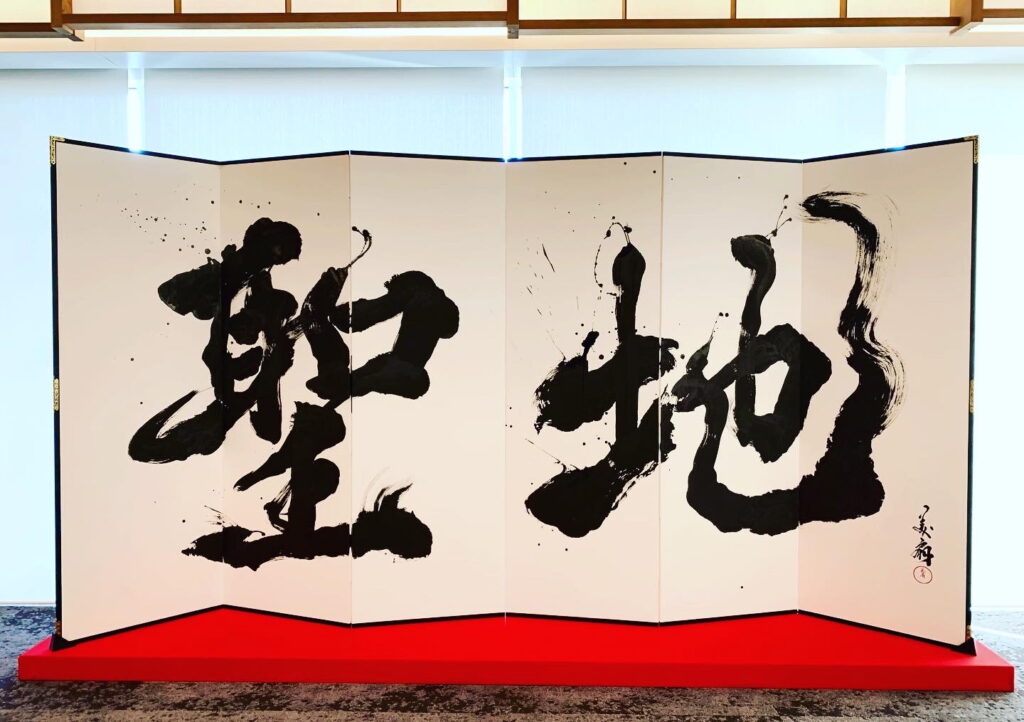
Q: In calligraphy, there are elements of stillness and movement, how do you express these in your work?
There is a mixture of ‘stillness’ and ‘movement’ in each letter. It is easy to imagine the difference between fast writing and slow writing, but there is also the difference between ‘quiet’ and ‘fast’ brush strokes, and between gentle and forceful strokes. The different characteristics complement each other to form a single character.
Q: Which do you feel is more important, technique or sensitivity?
Both are important. Even if you have excellent sensitivity, if you don’t have the right technique, you won’t be able to write good calligraphy, and conversely, if you only have technique but no sensitivity, you won’t be able to produce work that will be appreciated. I think that both are essential elements, but I think that basic skills are a prerequisite.
Q: How do you think about collaborating with different art forms?
Our work is about combining traditional calligraphy with innovative techniques. By collaborating with different disciplines, we want to expand the possibilities of calligraphy and show its appeal to as many people as possible. Pursuing new ways of expression is a great challenge and a lot of fun.
Q: If you were to convey the appeal of calligraphy to an international audience, how would you describe it?
I feel that the greatest appeal of calligraphy is that it is truly an art of the moment. I would like to convey the instantaneous beauty of the brushwork, the spirituality behind it and the cultural context. People from overseas are often greatly surprised when they learn the meaning behind the characters. The Japanese language can be read and expressed in many different ways, and I want to convey its deep meaning and beauty.
Q: What do you think about the future of calligraphy?
I think the future of calligraphy is very bright. As digitalisation progresses, I feel that the warmth and power of letters written with a brush will become more prominent. Another great hope is that the younger generation is taking a new perspective on calligraphy and pursuing their own unique expressions. In the Calligraphy Performance Koshien, for which I am an ambassador, more than 100 schools from all over the country have entered, and high school students are passionately engaged in calligraphy. I am convinced that these young forces will open up the future of calligraphy. Furthermore, by attempting to integrate AI technology and digital art, calligraphy continues to expand its potential for new forms of expression. By adopting innovation while preserving tradition, it will further increase its recognition and reputation both at home and abroad. It is extremely important that calligraphy is enlivened by the power of the younger generation. However, I feel that as we expand our range of expression through various challenges, we will eventually naturally return to traditional calligraphy. While pursuing new forms of expression, there are moments when we realise that there is essential beauty in the techniques and spirituality that have been handed down from ancient times. I am convinced that by reaffirming tradition, a deeper expression is born. I want to convey the appeal of calligraphy to as many people as possible, repeating tradition and innovation.
Q: What do you think is the relationship between writing and the state of mind?
I think it is possible that the state of one’s mind comes out in one’s writing. I think you have to keep your body healthy, and I think you have to keep your mind in good shape. It’s very interesting, but there are times when I’m in a bit of a slump and my rebellious spirit kicks in and I write a good piece, and there are other times when my mind and body are fine but I don’t do so well, so I really feel that calligraphy is a living thing.
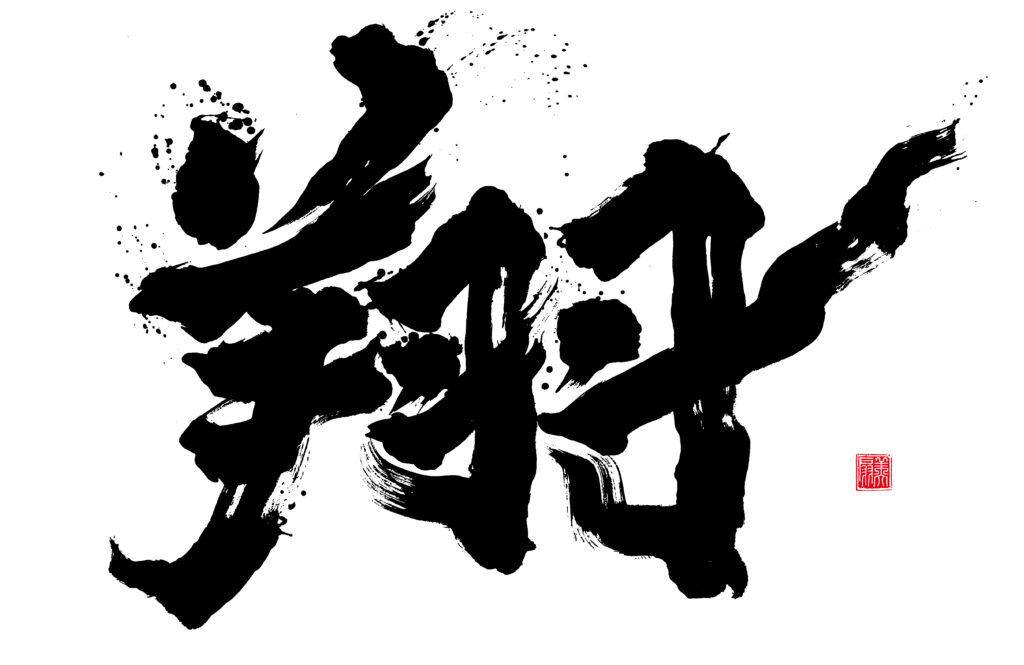
Q: Is there a country abroad that has left the greatest impression on you?
I have performed calligraphy in more than 10 countries, but the United Arab Emirates left a particularly strong impression on me. I came into contact with the Arabic calligraphy culture and experienced a way of being that is different in beauty from Japanese calligraphy. The country is also characterised by its own unique beauty, which is the opposite of Japanese wabi-sabi. When we organised a calligraphy workshop, we were freshly impressed by the way the participants handled the brush with a free sensibility and created expressions that were not bound by tradition. This experience gave me a new perspective on my own expression.
İt’s a great experience for me, but it also gave me a new perspective on my own expression.
I love it. I started at the age of four and have been doing it for 30 years, and I have loved calligraphy since I was really young and have never disliked it. I believe that calligraphy has a unique charm because it is an art of the moment, a work of art that can never be the same twice.
Q: What do you do when you want to express an emotion with just one letter?
When expressing emotions with a single character, I am conscious of expressing emotions not only through the meaning of the character itself, but also through its shape and the movement of the brush. For example, when I write the character for “smile”, I try to create an atmosphere where the character is smiling, as if the person is really smiling. Recently, I sometimes use acrylic paints and write with happy colours.
İt’s a challenge for me, but I’d like to try my hand at it in the future.
I would like to take on more exciting, large-scale and spectacular challenges. For example, I would like to try my hand at calligraphy on a huge canvas, such as the fuselage of an aeroplane or the wall of a school building, or a project where I work together with children and creators from around the world to create a single work of art. I want to surprise viewers with the overwhelming scale and power of my work, and I also want to take on challenges that I can truly enjoy.
Q. Is there anything new you’d like to work on, making use of your calligraphy?
Recently, I have been challenging new expressions of calligraphy using VR technology and XR. I am developing a system for the Osaka/Kansai Expo that will allow me to freely write letters in a virtual space using a brush-shaped controller. In addition to being able to write brush characters, our team is also creating content for experiencing Japanese culture using a brush, such as putting eyes in Daruma dolls and colouring in Ukiyo-e woodblock prints. In the future, we are also looking at works that combine calligraphy and AI technology.
Q: As you continue to practise and create calligraphy, are there any habits that you cherish on a daily basis?
I value the daily contact with calligraphy. Even on days when I don’t have a brush, I make a conscious effort to make time to look at my law books and study the classics, so that I can deal with calligraphy. This habit helps me to hone my sensitivity and motivates me to take on new challenges. I also receive inspiration from nature and art through walks and visits to museums, which feeds my creativity and broadens my range of expression.
About the work ‘Outline of Love’ published on
The Shape of Love. Through vigorous brushstrokes and bold margins, the artist expresses the power and fragility of the emotion of love. The splashes of ink and dynamic lines symbolise the imperfections and fluctuations of love, the way it changes form, sometimes violently, sometimes gently.
Love is not one definite form, but has countless contours. I embraced the beauty of the coincidences that arise in the course of the brushstrokes, and inscribed the uncontrollable emotions directly onto the paper.
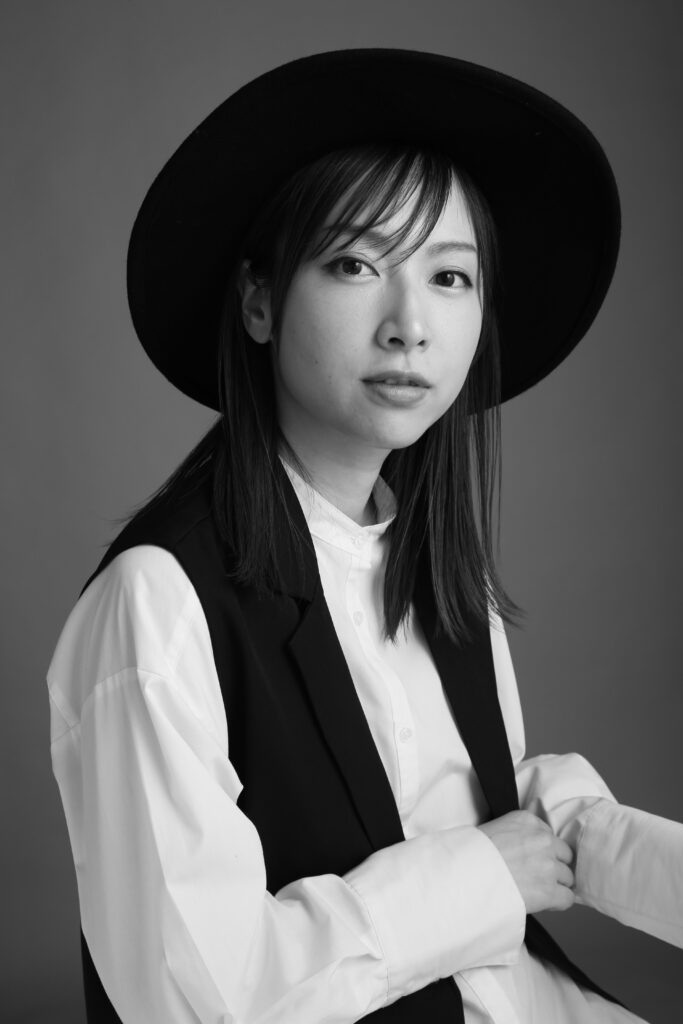
PROFILE
Calligrapher/artist Bisen Aoyagi
Born in Osaka. Started learning calligraphy at the age of four under the influence of her grandmother. She performed calligraphy at the 99th Emperor’s Cup in front of 58,000 spectators at the National Stadium. Dedicated a giant folding screen at the World Heritage Site “Koyasan”. Major works: dedication of the World Heritage Site ‘Koyasan’, CAPCOM ‘Monster Hunter Rise’, ‘Tokyo 2025 World Athletics Championships’, “Dororo” based on Osamu Tezuka’s novel, JRA ‘Arima Kinen’, ‘VIP Room’ at the National Stadium, etc. Appearance on TBS ‘Jounetsu Tairiku’, regular on NHK e-TV ‘Nihongo de Asobo’. etc.

